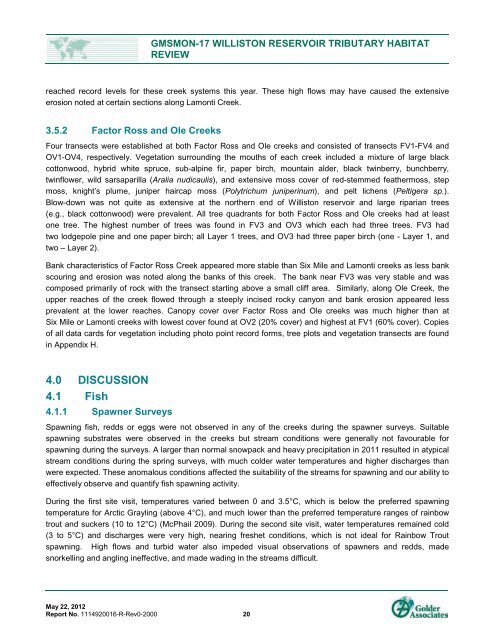GMSMON-17 WILLISTON RESERVOIR TRIBUTARY - BC Hydro
GMSMON-17 WILLISTON RESERVOIR TRIBUTARY - BC Hydro
GMSMON-17 WILLISTON RESERVOIR TRIBUTARY - BC Hydro
You also want an ePaper? Increase the reach of your titles
YUMPU automatically turns print PDFs into web optimized ePapers that Google loves.
May 22, 2012<br />
Report No. 1114920016-R-Rev0-2000 20<br />
<strong>GMSMON</strong>-<strong>17</strong> <strong>WILLISTON</strong> <strong>RESERVOIR</strong> <strong>TRIBUTARY</strong> HABITAT<br />
REVIEW<br />
reached record levels for these creek systems this year. These high flows may have caused the extensive<br />
erosion noted at certain sections along Lamonti Creek.<br />
3.5.2 Factor Ross and Ole Creeks<br />
Four transects were established at both Factor Ross and Ole creeks and consisted of transects FV1-FV4 and<br />
OV1-OV4, respectively. Vegetation surrounding the mouths of each creek included a mixture of large black<br />
cottonwood, hybrid white spruce, sub-alpine fir, paper birch, mountain alder, black twinberry, bunchberry,<br />
twinflower, wild sarsaparilla (Aralia nudicaulis), and extensive moss cover of red-stemmed feathermoss, step<br />
moss, knight’s plume, juniper haircap moss (Polytrichum juniperinum), and pelt lichens (Peltigera sp.).<br />
Blow-down was not quite as extensive at the northern end of Williston reservoir and large riparian trees<br />
(e.g., black cottonwood) were prevalent. All tree quadrants for both Factor Ross and Ole creeks had at least<br />
one tree. The highest number of trees was found in FV3 and OV3 which each had three trees. FV3 had<br />
two lodgepole pine and one paper birch; all Layer 1 trees, and OV3 had three paper birch (one - Layer 1, and<br />
two – Layer 2).<br />
Bank characteristics of Factor Ross Creek appeared more stable than Six Mile and Lamonti creeks as less bank<br />
scouring and erosion was noted along the banks of this creek. The bank near FV3 was very stable and was<br />
composed primarily of rock with the transect starting above a small cliff area. Similarly, along Ole Creek, the<br />
upper reaches of the creek flowed through a steeply incised rocky canyon and bank erosion appeared less<br />
prevalent at the lower reaches. Canopy cover over Factor Ross and Ole creeks was much higher than at<br />
Six Mile or Lamonti creeks with lowest cover found at OV2 (20% cover) and highest at FV1 (60% cover). Copies<br />
of all data cards for vegetation including photo point record forms, tree plots and vegetation transects are found<br />
in Appendix H.<br />
4.0 DISCUSSION<br />
4.1 Fish<br />
4.1.1 Spawner Surveys<br />
Spawning fish, redds or eggs were not observed in any of the creeks during the spawner surveys. Suitable<br />
spawning substrates were observed in the creeks but stream conditions were generally not favourable for<br />
spawning during the surveys. A larger than normal snowpack and heavy precipitation in 2011 resulted in atypical<br />
stream conditions during the spring surveys, with much colder water temperatures and higher discharges than<br />
were expected. These anomalous conditions affected the suitability of the streams for spawning and our ability to<br />
effectively observe and quantify fish spawning activity.<br />
During the first site visit, temperatures varied between 0 and 3.5°C, which is below the preferred spawning<br />
temperature for Arctic Grayling (above 4°C), and much lower than the preferred temperature ranges of rainbow<br />
trout and suckers (10 to 12°C) (McPhail 2009). During the second site visit, water temperatures remained cold<br />
(3 to 5°C) and discharges were very high, nearing freshet conditions, which is not ideal for Rainbow Trout<br />
spawning. High flows and turbid water also impeded visual observations of spawners and redds, made<br />
snorkelling and angling ineffective, and made wading in the streams difficult.
















